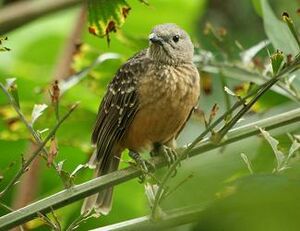Fawn-breasted bowerbird facts for kids
Quick facts for kids Fawn-breasted bowerbird |
|
|---|---|
 |
|
| Conservation status | |
| Scientific classification | |
| Genus: |
Chlamydera
|
| Species: |
cerviniventris
|
The fawn-breasted bowerbird (scientific name: Chlamydera cerviniventris) is a special type of bird known for building amazing structures called 'bowers'. These birds are about 32 centimeters (12.6 inches) long, which is about the size of a ruler. They have greyish-brown feathers with white spots, a black beak, dark brown eyes, and a yellowish-orange belly. Both male and female birds look similar, but the female is a little smaller.
Contents
About the Fawn-breasted Bowerbird
Where They Live and What They Eat
Fawn-breasted bowerbirds live in New Guinea and the northern part of the Cape York Peninsula in Australia. You can find them in different places like tropical forests, mangrove swamps, and the edges of woodlands.
Their favorite foods include figs, other fruits, and insects. They build their actual nests, which are loose cups made of small sticks, high up in trees.
Building a Bower
Bowerbirds are famous for their unique "bowers." These are not nests for eggs, but special structures built by the male bird to attract a female. The fawn-breasted bowerbird builds an "avenue-type" bower. This means it has two walls made of sticks, forming a pathway. The male bird decorates this pathway with colorful items, especially green berries, to make it look appealing.
Conservation Status
Good news! The fawn-breasted bowerbird is quite common in the areas where it lives. Because of this, it is listed as "Least Concern" on the IUCN Red List of Threatened Species. This means it is not currently in danger of disappearing.
First Discovery of the Fawn-breasted Bowerbird
An Expedition to Cape York
The fawn-breasted bowerbird was first officially observed and collected during an expedition by the ship H.M.S. Rattlesnake between 1846 and 1850. John MacGillivray, a naturalist on the expedition, wrote about finding this bird.
He heard that some bowerbirds had been seen near Cape York. After searching, he found a newly built bower. It was about four feet long and eighteen inches high, with fresh berries placed on it. The bower was located in a thick group of bushes.
Observing a Wary Bird
MacGillivray went back to the bower early the next morning to try and observe the bird. He described the bird, which the local people called tervinya, as very careful and hard to spot. It would dart through the bushes, making a loud "churr-r-r" sound. It also copied the calls of other birds, like the leather-head.
The bird would often trick him, flying off and then landing on the bower to place a berry or two, only to fly away again before MacGillivray could get close. Finally, after waiting patiently, he saw the bird enter the bower. He fired his gun, and luckily, he hit it.
This bird turned out to be a new species! It was later described by John Gould and given the scientific name Chlamydera cerviniventris. The bower that MacGillivray found was even put on display in the British Museum.
Gallery






